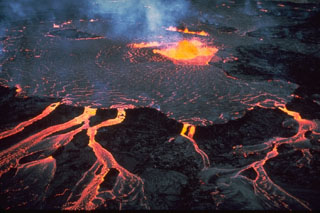Report on Kilauea (United States) — 25 June-1 July 2025
Smithsonian Institution / US Geological Survey
Weekly Volcanic Activity Report, 25 June-1 July 2025
Managing Editor: Sally Sennert.
Please cite this report as:
Global Volcanism Program, 2025. Report on Kilauea (United States) (Sennert, S, ed.). Weekly Volcanic Activity Report, 25 June-1 July 2025. Smithsonian Institution and US Geological Survey.
Kilauea
United States
19.421°N, 155.287°W; summit elev. 1222 m
All times are local (unless otherwise noted)
The Hawaiian Volcano Observatory (HVO) reported that the eruption within Kilauea’s Kaluapele summit caldera, characterized by episodic fountaining and intermittent spatter at two vents along the SW margin of Halema’uma’u Crater, continued at variable levels during 25 June-1 July. Nighttime incandescence at both the N and S vents was visible overnight during 24-28 June and intermittent lava spattering at the N vent was visible during 26-29 June. Small, sporadic dome fountains and intermittent lava overflows at the N vent began at 0727 on 29 June. Small, sustained lava fountaining began at 0803 and the fountains slowly grew over the next hour; at 0905 the height and vigor of the fountains increased notably. The fountains were as high as 150 m by 0931 and multiple lava flows were advancing on the crater floor. An eruption plume rose at least 6 km (20,000 ft) above the ground; variable winds blew gas and tephra plumes in different directions. The fountains rose higher, reaching 340 m for several hours. The activity started to wane and ceased at 1954, after 11 hours of continuous fountaining. Flames were visible at the S vent for a few minutes afterwards. The N vent produced an estimated 6.2 million cubic meters of lava covering about 80 percent of the crater floor. The Volcano Alert Level remained at Watch (the third level on a four-level scale) and the Aviation Color Code remained at Orange (the third color on a four-color scale).
Geological Summary. Kilauea overlaps the E flank of the massive Mauna Loa shield volcano in the island of Hawaii. Eruptions are prominent in Polynesian legends; written documentation since 1820 records frequent summit and flank lava flow eruptions interspersed with periods of long-term lava lake activity at Halemaumau crater in the summit caldera until 1924. The 3 x 5 km caldera was formed in several stages about 1,500 years ago and during the 18th century; eruptions have also originated from the lengthy East and Southwest rift zones, which extend to the ocean in both directions. About 90% of the surface of the basaltic shield volcano is formed of lava flows less than about 1,100 years old; 70% of the surface is younger than 600 years. The long-term eruption from the East rift zone between 1983 and 2018 produced lava flows covering more than 100 km2, destroyed hundreds of houses, and added new coastline.
Source: US Geological Survey Hawaiian Volcano Observatory (HVO)

